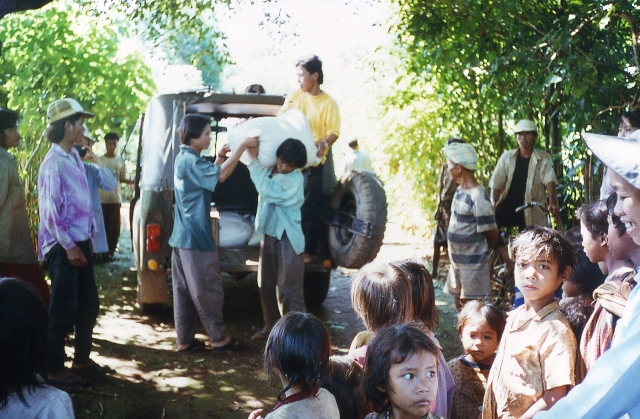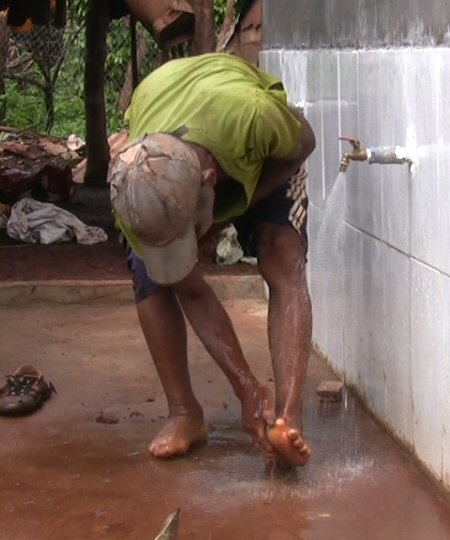We develop a holistic approach to care for people with leprosy. Following the development of the Multi-Drug Therapy (MDT) in 1981 that can effectively cure leprosy, there was widespread optimism for the elimination of leprosy. The leprosy causing Mycobacterium leprae multiplies very slowly and is one of the least infectious disease because it usually requires frequent contacts with untreated cases and 99% of the population has adequate natural immunity. Furthermore, over 85% of the clinical cases are non-infectious and an infectious case is often rendered non-infectious within one week, most often after just one dose of treatment. For these reasons, the optimism seemed well founded. Yet many years have passed and leprosy is still with us. Why?
In serving the lepers, the Damien the Leper Society has adopted a holistic approach. In every leper, D.L.S. sees a total human being, not just a creature with a disease to be cured. We see that, beside the disease, there are many contributing factors that prevent us from eradicating the disease. Also of grave concern to D.L.S. are the children. What can their future be if they grow up in such unsanitary conditions, lacking food and nutrition, given little or no education, constantly exposed to the dreaded disease? They must be removed from the colony, fed and housed, educated, and prepared for a normal future in society. Otherwise, there will be only a continuation of the pitiful leprosy cycle into the next generation. We believe that only a holistic approach that addresses all the following issues of leprosy can rid mankind of this dreaded disease.
Access to health care

Even though the World Health Organization provides MDT drugs free to all endemic countries since 1995, many of the lepers in remote locations still don’t get access to these drugs. In countries like Vietnam, our society has local representatives and contacts who are willing and able to travel to bring the cure to the afflicted.
Education
Even when the MDT drugs are available, the drugs have to be taken in specific regimen that can be difficult to understand to the uneducated. For example Rifampicin has to be taken once a month, while Dapsone has to be taken daily and Clofazimine has one large dose per month, plus a daily dose as well. In developed countries we have healthcare professionals to administer the drug, but in these remote regions, the drugs are in the hands of the afflicted to care for themselves. Furthermore, the lepers must also learn to recognize that the anesthesia effect of the disease reduces the sensation in their extremities, leading to accidental self injuring actions. Our society has healthcare professionals that are able to communicate to the afflicted and teach them how to self administer the drug and properly care for their wounds to minimize secondary deformities. The society also sponsors the construction of schools and provides scholarships to children of lepers.
Social stigma
For thousands of years leprosy has been considered a curse and the afflicted were outcasts from society. Modern society has reduced that stigma somewhat but the feeling of shame still is pervasive among the afflicted. In many cases, young lepers often hide their symptoms and do not get the treatment they desperately need. When members of our society travel to locations with high concentration of leprosy cases, in addition to providing treatments, we also educate the people, letting them know that leprosy is simply a disease caused by bacteria and one needs not feel shameful for having contracted the disease.
Sanitation

Often the lepers live in areas of poor sanitation. Lack of knowledge of sanitation and not having the means to stay clean often cause secondary infections that in turn leads to secondary deformities and even deaths to many of the afflicted. Our society sponsors projects that bring clean water, protective shoes to the lepers to help keep them clean.
Poverty
Since the lepers are often driven from civilization they are forced to live in extreme poverty. This leads to continuation of leprosy to the next generations. For many of the children of lepers, there is no way out. Living in these extreme conditions and sooner or later, many of these children will contract leprosy and the disease lives on. Our society sponsors projects that provide housing for the lepers, provide them with seeds, live stocks, and teach them how to raise crop and animal husbandry. We help provide the lepers with means to lift them out of poverty. With our multi-front approach to caring for people with leprosy, our society helps heal the lepers, administers to the effect of the disease, and helps lift the lepers to a life free of leprosy.
